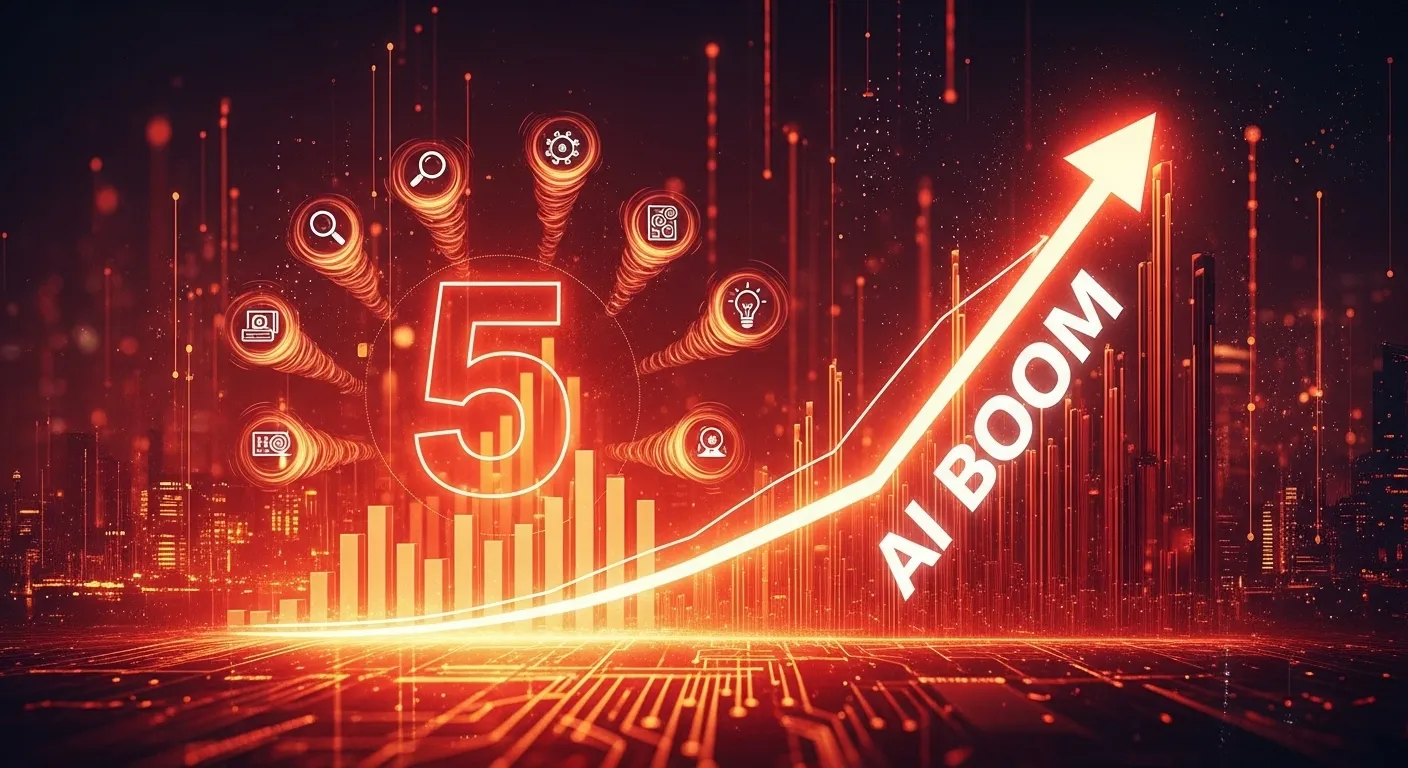The AI rocket is still screaming upward—but for how long can it keep burning at this throttle? Between record GPU sales, power-hungry data centers, and eye-watering VC rounds, the answer depends on seven very real constraints and catalysts playing tug-of-war right now.
What Is the “AI Boom”?
Short version: an unprecedented build-out of chips, data centers, models, and money. Nvidia’s data-center revenue has posted historic growth, AI-ready capacity is the fastest-growing slice of infrastructure, and venture funding has re-accelerated with AI taking a dominant share. Analysts now forecast data-center electricity demand to more than double by 2030 with AI as the main driver—turning power, memory, and packaging into headline constraints rather than footnotes.
How It Works (The Flywheel)
Practically, the boom runs on a flywheel:
- Compute supply spikes: New generations (Hopper → Blackwell → Rubin) plus advanced packaging (CoWoS) and HBM scale up, enabling bigger, cheaper, faster models.
- Model & product leaps: Cheaper inference and better small models widen practical use cases across software, customer ops, analytics, and R&D.
- Enterprise adoption: Pilots become production as workflows are rewritten and data plumbing improves—unlocking real P&L impact.
- Capital pours in: Profits and narratives attract VC and corporate capex, which fund more compute—completing the loop.
The million-dollar question: which parts of the loop hit friction first?
Benefits & Use Cases
- Productivity lift: Software engineering, support, marketing, and operations see cycle-time reductions and quality gains—translating into real margin expansion for early movers.
- Revenue acceleration: New AI-native features (agents, copilots, voice) unlock upsell and new SKUs, especially in SaaS and fintech.
- Sector plays: Healthcare triage, industrial inspection, logistics routing, precision retail, and energy forecasting are maturing from pilots to production.
Costs/Pricing
GPUs & cloud: H100/H200 rental rates commonly range from roughly $3–$10 per GPU hour depending on provider and commitment; headline cloud cuts in mid-2025 trimmed on-demand prices. Buying top-end accelerators can run $25k–$40k per GPU, with next-gen systems (e.g., GB200) shifting economics again. Bottom line: hybrid (own + rent) often beats pure cloud for predictable training, while on-demand remains vital for bursts.
Power: Electricity is the sleeper line item. As clusters scale, power & cooling can rival hardware depreciation. Projections show data-center electricity use doubling by 2030, keeping energy procurement (PPAs, on-site gen, nuclear deals) front and center.
HBM & packaging: HBM capacity is tight through 2026 even as suppliers ramp; CoWoS packaging remains a gating factor until expansions fully land. Expect periodic scarcity premiums and long lead times to persist near-term.
Local Insights (GEO)
South Asia snapshot: India’s data-center capacity is forecast to grow several-fold by 2030, drawing PPAs and grid modernization as hyperscalers localize AI workloads. Bangladesh is laying groundwork—green data-center initiatives and policy roadmaps are emerging—though infrastructure, skills, and financing remain hurdles. For regional buyers, near-term wins often come from cloud GPUs plus targeted on-prem nodes where workloads are steady.
Alternatives & Comparisons
- Closed vs open models: Closed models still lead on raw capability and enterprise tooling; open weights are rapidly closing the gap on key tasks with superior cost control and customization.
- Cloud-only vs hybrid/on-prem: Cloud wins for speed and elasticity; hybrid reduces long-run TCO for predictable training and high utilization, with better data control.
Step-by-Step Guide
- Quantify value fast: Select 2–3 use cases with measurable impact (hours saved, conversion lift). Establish baselines now.
- Right-size the stack: Choose model class (closed/open, small/large), sourcing (cloud/hybrid), and memory/networking to fit latency and privacy constraints.
- Harden & scale: Productionize with guardrails (prompt evals, red-teaming), observability, cost dashboards, and power planning. Negotiate multi-year capacity and energy early to dodge supply shocks.
FAQs
Is the AI boom sustainable?
Likely yes through the late-2020s, but with volatility. Semiconductor supply (HBM, advanced packaging), power availability, and real enterprise ROI are the swing factors. Expanding fab/packaging lines and falling inference costs are tailwinds; grid bottlenecks and spot GPU pricing are headwinds.
How long does it take to see ROI?
Pilot paybacks can appear in weeks; durable enterprise ROI usually takes 6–18 months as teams rewire workflows, tune models, and clean data. The big gains arrive when AI is embedded into processes—not just layered on top.
Are there risks?
Yes—vendor lock-in, cost runaways, IP/data exposure, and regulatory drift. Mitigate with hybrid infra, strong data governance, model choice portability, and continuous evaluation. Track local rules (EU AI Act; evolving US state/federal action) if you operate cross-border.
Bottom Line
The AI boom can plausibly sustain an elevated pace for another 3–5 years, if three things happen in parallel: (1) packaging and HBM supply expand on schedule, (2) data-center power growth is matched by new generation and PPAs, and (3) enterprises move from pilots to re-designed workflows that show repeatable ROI. Watch those three dials—if they turn green, the engine keeps roaring.
Sources
- Nvidia Q2 FY2026 results (Data Center growth)
- IEA — AI to more than double data-center electricity demand by 2030
- Stanford HAI — AI Index 2025 (compute, costs, efficiency)
- CB Insights — AI trends and funding Q2 2025
- McKinsey — AI power & data-center capacity outlook
- AWS — 2025 GPU instance price reductions
- JarvisLabs — H100 pricing guide (buy vs rent)
- HBM market share & supply outlook (SK hynix/Micron/Samsung)
- US Executive Order (2025) — AI policy shift
- EU AI Act — high-level summary
- India data-center capacity growth projections
- Bangladesh — AI roadmap comments (policy direction)

